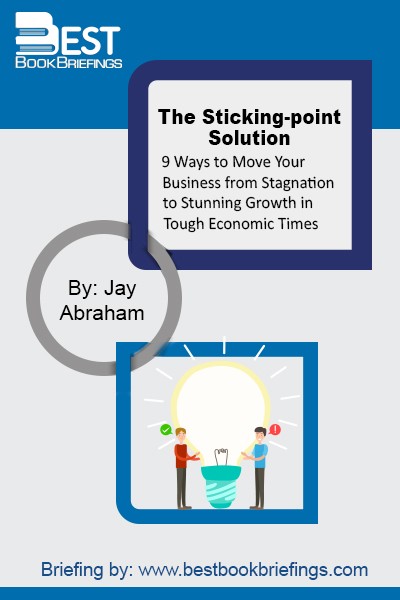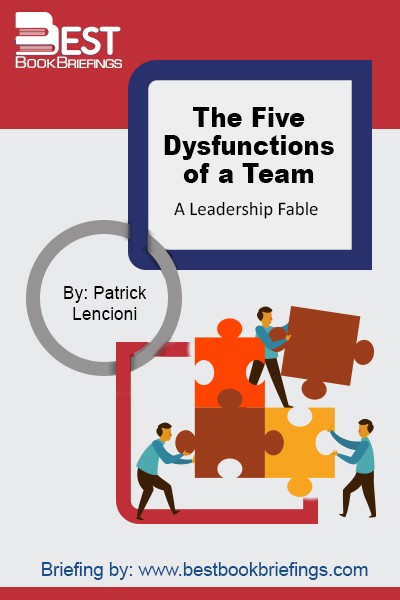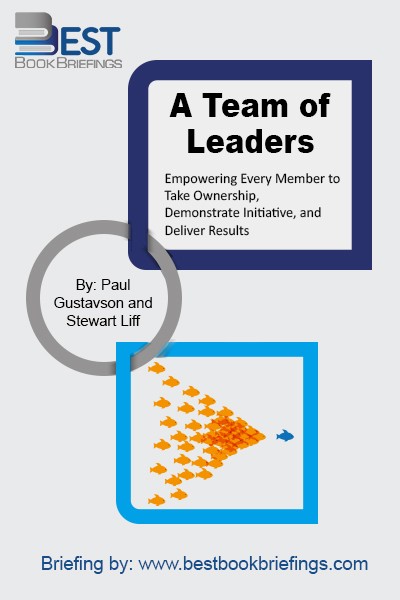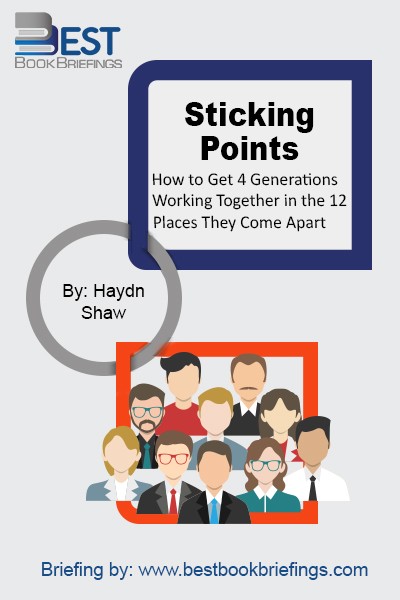Sticking Points
How to Get 4 Generations Working Together in the 12 Places They Come Apart
Number of pages: 264
Publisher: Tyndale House Publishers, Inc.
BBB Library: Human Resources
ISBN: 9781414364711
About the Author
He has worked with more than 1,500 businesses, not-for-profit organizations, and government agencies, speaking and consulting on leadership, change, and generational differences.
Read More...Editorial Review
Employees in the workplace belong to different generations which impact their way of thinking and how they see matters. These generational differences are what we call Sticking Points. Knowing these sticking points can allow teams to label tension points and work through them – even anticipate and preempt them. But most organizations don’t know that. Sticking points are inevitable and they often get teams stuck. But they don’t have to. The same generational conflicts that get teams stuck can cause teams to stick together.
Book Reviews
"Sticking points can be negative if you see them as problems or positive if you see them as opportunities for greater understanding and flexibility. Sticking points can make things worse or better, depending on whether the four generations can work together in the 12 places they naturally tend to come apart"mygenerationalcoach.com
Books on Related Topics

by Karen Phelan
In this book we get to know that human assets aren’t a part of a business. If you take away the human assets, you don’t have a business, just a bunch of offices and equipment that can’t do anything. Businesses are people–irrational, emotional, unpredictable, creative, oddly gifted, and sometimes ingenious people

by Jay Abraham
The purpose of The Sticking Point Solution is to help entrepreneurs and executives recognize the ways in which their businesses may be stuck, and to then give them tools for getting unstuck and enjoying exponential growth. To achieve this, Jay will help you to identify the nine “sticking points” that keep

Perhaps more than any of the other dysfunctions, the leader must set the tone for a focus on results. If team members sense that the leader values anything other than results, they will take that as permission to do the same for themselves. Team leaders must be selfless and objective and

If you are a supervisor or a team leader, you know how difficult it is to run a unit or a team. You’ve the one job where everyone seems to give you a hard time; management demands improved performance, employees want you to solve their problems, other units need you to
Wisdom to Share
Employees in the workplace belong to different generations which impact their way of thinking and how they see matters. These generational differences are what we call Sticking Points.
Each generation attempts to maneuver the others into seeing the sticking point their own way. And that is the first mistake – viewing the sticking point as a problem to be solved rather than an opportunity to be leveraged.
The historical events during a generation’s childhood years shape their values, worldview, and definitions of success. Their shared experiences are what distinguish them as a generation in the first place.
Traditional ran hierarchical organizations using a command and control approach that expected employees to fall in line, prove their loyalty, and do their duty.
When Boomers act like workaholics (and expect you to as well), you have to remember how overcrowded hospitals, schools, sport teams, campuses, and job markets taught them that you have to compete to get what you want.
Boomers grew up in one of the most economically optimistic time in history. They didn’t save money the way their Depression era parents had.
Traditionalists and Baby Boomers believed in delayed gratification – work hard today and get rewarded tomorrow.
Political events have shaped Millennials’ culture in two major ways. First, they learnt not to wait until tomorrow to do something important. Second, they have a strong impulse to keep work and life in balance.
It’s okay to think about a different generation in the same way we might think about a different country – Nice place to visit, but I don’t want to live there.
Our own generation will always feel like home. But that doesn’t mean we can’t visit other cultures and learn to appreciate them and to speak their languages.
If your organization is going to succeed with Millennials, you’re going to have to get familiar with the tools they can’t live without. The point here is to figure out the language of other generations and try to speak it.
Different generations’ backgrounds have an impact on their views on decision-making. Traditionalists grew up and began their careers in hierarchical organizations where the bosses made the decisions. While Baby Boomers pushed their organizations to give people a greater voice.
Gen Xers learned from technology and non-traditional families to let the savviest person on the topic make the call.
When Millennials show up in a situation that uses a top-down decision-making model, they get frustrated. They want broader, more inclusive decision-making process.
All generations want the same things: To be comfortable, attractive, and taken seriously. It helps to remember also that each generation is less formal than the one before it.
Traditionalists see that formal dress shows respect in and out of the workplace, while Baby Boomers wear the expected uniform at work, but they’re casual at home.
Millennials saw many different versions of formal dress around the world. To them clothing makes a statement about personal style, not ability.
If you build dress code policies around concrete business reasons rather than what you assume to be common sense, you’ll be in good shape.
Everyone needs to know how they are doing at their job and how they can improve, but each generation has its own perspective.
Traditionalists didn’t expect a lot of feedback and they didn’t give it. It is like the saying “No news is good news.” They were raised with a focus on obedience, not praise.
Xers didn’t need to compete with one another, so performance appraisals were not life or death for them. Instead, they thought performance appraisals were too complicated and after the fact.
You should satisfy the needs of your employees of different generations and it is a business necessity to give them the information they need to do their jobs well.
Ask your team members what kind of feedback they want to receive. They know their own preferences and can keep you from wasting time on feedback that isn’t as helpful to them.
Fun itself isn’t the generational sticking point. All the generations want fun; the sticking point is that they don’t agree on how much fun is appropriate.
Unlike Traditionalists, the idealistic Boomers expected more than money from work. They expected to find self-discovery, meaning and self-fulfilment.
Xers want to do work that they enjoy, but it’s still work. That is why you have to mix in some fun along the way.
What Xers don’t want is pre-planned fun that feels forced and makes meetings go longer, keeping them from getting out the door on time.
As for Millennials, fun is fuel. Playfulness and humor have been deeply integrated into every aspect of Millennials’ lives. As a result, they are used to fun baked into whatever they do.
People need information to do their jobs. But each generation want to gain and give that information in a way that makes sense to them.
Millennials did not grow up with oral stories. They’ve grown up watching videos and reading. When they need information, they fire up a search engine and watch a video that explains it, look for online documentation, or post a question, and someone gives them an answer.
You get loyalty when you appreciate the needs of your employees. Although needs differ from one generation to another, there are shared ones: Security and opportunity.
49% of all employees think meetings are a waste of time because each generation on your team doesn’t understand why the other generations answer the question differently about how meetings should go.
Millennials have always worked in teams and groups, so they don’t dislike all meetings, only boring meetings. To them, texting or e-mailing or bringing up a funny video or a topic not on the agenda during meetings is not rude, it’s part of connecting, engaging.
The Boomers rebelled against their parents’ authority and anything that limited their creativity and fulfilment. They believed anyone could work their way up to a position where they could earn respect.
For Xers, ability matters more than position. They respect those who have skills and deliver results rather than those who have an official position in the hierarchy.
Millennials respect those who respect them. They know that younger employees don’t have the same knowledge or experience as the older generations, but they believe that everyone should have his ideas taken seriously.
What Millennials need is interaction. They also want to contribute to knowledge rather than passively memorize information.
Xers believe that if they aren’t learning new skills or software or building a resume, they’re falling behind. They don’t see training as a reward for a few, but as essential for all.
Millennials have high expectations, but they’re the only generation that doesn’t cite “work ethic” as one of their principal distinctives, nor do they rate themselves as work-centric as the Traditionalists and Boomers do.
Hours worked is not a valid measure for many jobs in today’s information-driven, global, 24/7 economy. Focus on the output not on the hours.
Each generation has its own insights and strengths. We need the four generations working together and sharing their insights in order to make the most productive, balanced, well-rounded teams.
Many Millennials don’t want to leave their organizations as much as they want to play different roles. You might not have new positions for them, but you can change up their jobs or invite them to help on a project team.
Try job sharing by having employees train others on their current jobs while learning new jobs themselves. This way, if employees leave, the company isn’t left empty-handed.
Make sure employees know what opportunities you have internally because new jobs are only a screen away
With four generations in the workplace, sticking points are inevitable, but getting stuck is avoidable, so you have to quit managing the generational differences and start leading.
Talk with your team about generational differences, appreciate them, flex, and resolve the conflict by determining which option will yield the best results.
Books by the same Author
Sticking Points

We couldn't find public videos for this title. Please check back later.


